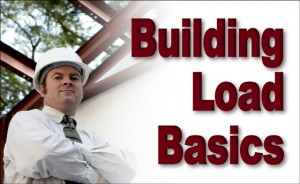Part 1: Understanding Dead Load and Live Load
To appreciate the work of structural engineers, you need some rudimentary knowledge of construction loads.
Metal building structural engineers analyze the strength and stability of a building. Their calculations determine the integrity and safety of a building design.
 Steel building engineers determine the placement and gauge of each part of the metal building system. Without the input of a certified structural engineer, a metal building might be “under-engineered,” meaning the building would fail to support its loads under duress, or “over-engineered,” meaning more steel is used than actually needed, making to structure too expensive.
Steel building engineers determine the placement and gauge of each part of the metal building system. Without the input of a certified structural engineer, a metal building might be “under-engineered,” meaning the building would fail to support its loads under duress, or “over-engineered,” meaning more steel is used than actually needed, making to structure too expensive.
Ideally, engineered metal buildings never compromise safety to cut costs— nor do they overbuild and inflate pricing.
Engineers incorporate “static” and “dynamic” load principles to design the strongest possible structure with the least amount of wasted material.
Dead Loads
Static loads, also known as “dead loads,” are the permanent loads of the structure.
Dead loads in buildings consist of the weight of the building itself, plus the weight of all fixed items like walls, roof, and carpeting.
Anything hung from or attached to the structural framing is a “collateral” dead load. Collateral loads cover objects like roof-mounted air-conditioning/heating units and HVAV ducting, water fire sprinkler systems, lighting fixtures, material handling systems, or interior manufacturing cranes. The soundness of the structure depends on the structural engineer knowing in advance all the auxiliary materials to be used in the building.
Dead loads include everything likely to remain over the lifetime of the structure.
You might expect concrete foundations to govern the maximum weight of the structure. Not so. Pre-engineered metal buildings are designed first, and then the concrete engineer creates the proper sized foundation to support the dead loads of the building.
Live Loads
Dynamic loads, better known as “live loads,” are the transient or temporary additional loads imposing additional force on a structure and its foundation.
The weight of a worker walking across a steel building roof is a live load. Any objects moved in and out the structure are live loads, including people (designated as “occupancy”), plants, furniture, and so forth. For example, in a garage, cars, trucks, boats, and RVs constitute live loads.
Steel mezzanine systems, used to create upper floors in metal buildings, are self-supporting. These systems work independently of the structural steel framing.
However, the mezzanine system must be engineered to sufficient carry the live loads of materials and people using them. The concrete engineers design the foundation based on the mezzanine’s placement and calculated loads.
Pre-engineered Metal Buildings: Model Efficiency
Basic pre-engineered steel buildings take the guesswork out of construction loads— and eliminate the need for hiring an expensive structural engineer for a building project. Pre-engineering efficiently crafts a sound, solid steel structure.
- Sophisticated structural steel software designs each project to the exact dimensions provided by the customer.
- Based on all dead and live construction loads— plus current local building codes— the software creates a 3-D structural framing plan.
- The software generates detailed drawings for every individual piece of the building frame. Each detailed drawing provides exact manufacturing information.
- An engineer licensed for that state checks over all the calculations and signs off on production.
- The customer receives three sets of plans to obtain construction permits. Three Letters of Certification signed by the engineer of record accompany the plans.
- A local concrete contractor engineers the required foundation based on the anchor bolt plan and specified construction loads.
This process results in a maximum strength structure at a minimum cost.
For more information about steel framing loads or ordering a pre-engineered RHINO steel building, please call 940.383.9566. We can answer all your questions and provide you with a free estimate for any building needs.
Environmental Loads
See part two of this series for information on the different environmental construction loads taken into inconsideration, such as seismic, snow, and wind loads.
